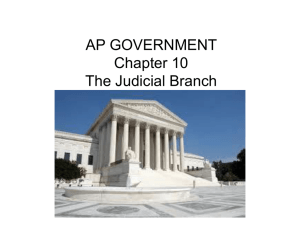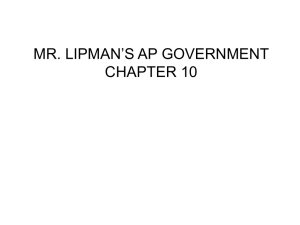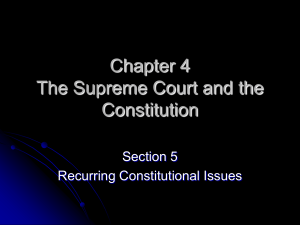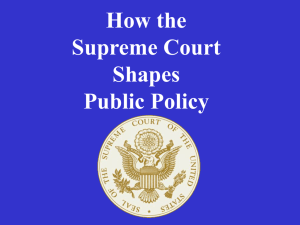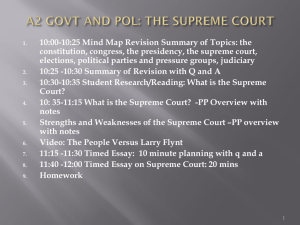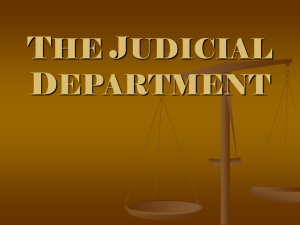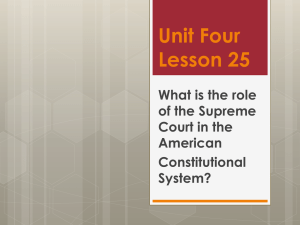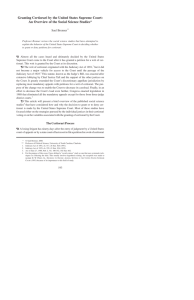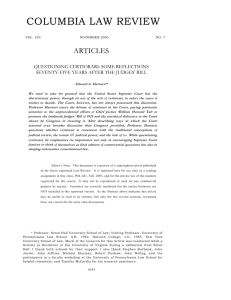AP PowerPoint 1
advertisement
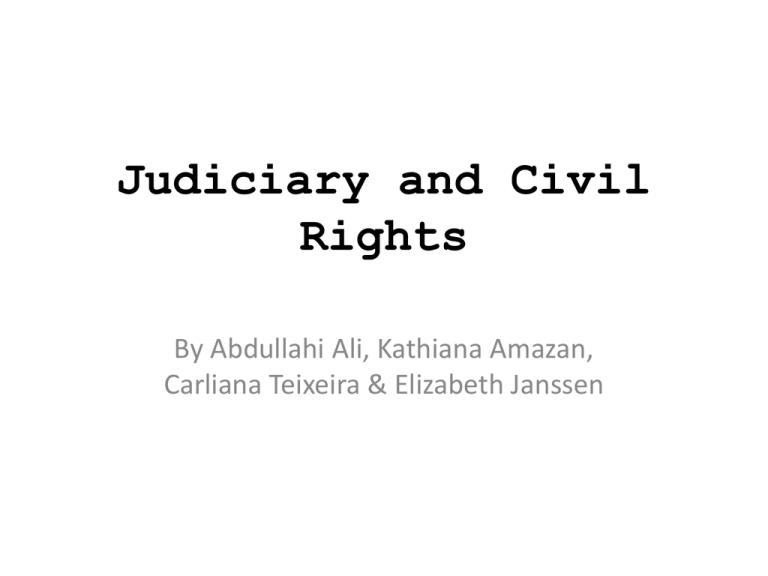
Judiciary and Civil Rights By Abdullahi Ali, Kathiana Amazan, Carliana Teixeira & Elizabeth Janssen 2011 Free Response The United States Supreme Court receives many appeals, but it hears and rules on a small percentage of cases each year. Numerous factors influence the actions of the Court, both in deciding to hear a case and in the decisions it hands down. A) Define judicial review. B) Explain how judicial review empowers the Supreme Court within the system of checks and balances. C) Describe the process through which the Court grants a writ of certiorari. D) Explain how each of the following influences decisions made by individual justices when deciding cases heard by the Court. • Stare decisis • Judicial activism a.)Define Judicial Review a.) To answer this, you need to know the definition of judicial review. Judicial review is defined as authority the courts the power to review constitutionality of acts by the executive, state or the legislature. This is an explicit check on all the other branches and even the states themselves. To also answer this question completely one must also reference the landmark case Marbury v. Madison which established judicial review. b.) Explain how judicial review empowers the Supreme Court within the system of checks and balances. b.) Judicial review empowers the Supreme Court within the system of checks and balances. This lets the court ultimately decide what acts and legislations can be classified as “constitutional”. In the system of checks and balances, this gives the courts an advantage over the executive and legislative branches because it opens up a passage for the court to strike down acts of the other two branches. c.) Describe the process through which the Court grants a writ of certiorari. c.) This question cannot be answered without knowing the definition of a writ of certiorari. A writ of certiorari is an order by The Court directing a lower court to send up the records of a case for review. This is usually enacted for the Court to be able to interpret law or decide a constitutional question. A key word of this question is rule of four, which means that four of the nine justices must agree to hear the case. So the process through which the Court grants a writ of certiorari is first the case is appealed and travels through the appellate courts until it reaches the Supreme Court. If the justices disagree with the lower court decision, they can agree to hear the case if four of the nine justices agree to hear the case, hence the rule of four. Then the court obtains the information necessary to proceed with the review of the case by using a writ of certiorari to order a lower court to send up the records of the case up. d.) Explain how each of the following influences decisions made by individual justices when deciding cases heard by the Court. • Stare decisis • Judicial activism d.) Stare decisis is the courts tendency to respect past precedent. Judicial activism is a judicial philosophy that calls for the court to play an active role in determining national policies and to apply the Constitution to social and political questions of their present day. Justices can be influenced by stare decisis if they feel an urge to not mess with previous rulings. Justices can be influenced by judicial activism if they feel that the Constitution needs to be applied to the problems of today, especially social problems where constitutional rights have been violated. Brown v. Brown of Education was a special case in which stare decisis was overturned and was a case in which judicial activism was displayed by a court that is synonymous with judicial activism. 2005 Free Response The judicial branch is designed to be more independent of public opinion than are the legislature or the executive. Yet, the United States Supreme Court rarely deviates too far for too long from prevalent public opinion. A) Describe two ways in which the United States Supreme Court is insulated from public opinion. B) Explain how two factors work to keep the United States Supreme Court from deviating too far from public opinion. A) Describe two ways in which the United States Supreme Court is insulated from public opinion. a.) Two ways in which SCOTUS is insulated from public opinion is the life term that allows the justices not fear public outcry over their decisions and allows them to review each of their cases as objectively as they can (partisanship clouds this objectivity however) and the justices are appointed and not elected as a congressman or president would be elected. B) Explain how two factors work to keep the United States Supreme Court from deviating too far from public opinion. b.) If the court operates too far from public opinion, there are several mechanisms in place that help reduce the power of the court. The court has to interpret the law and not enforce it, so if the court went rogue and made some very dangerous and unpopular rulings, the executive can simply not enforce it. Another factor that helps keep the court in public opinion is the appointment and confirmation process that makes sure the court is not too crazy with power. The Senate has to approve the justice, so they get to ask many questions that show the justices views. One example to add could be Robert Bork and his failed confirmation hearings after he revealed that he does not support abortion. This lead to an epic failure on his part and Bork not even being confirmed. AP Questions In 1987 the cooperation among the NAACP, the National Organization for Women (NOW), and the American Civil Liberties Union (ACLU) to defeat Robert Bork’s nomination to the United States Supreme Court was an example of: (A) Impeachment (B) Litigation (C) Coalition building (D) The recall process (E) The initiative process Correct Answer: C; impeachment: accuses someone of misconduct in a political office; litigation: a legal proceeding in a court. Also pay attention to the fact that the listed groups are all interest groups that worked together to achieve something political and connect that to coalition in choice C which usually represents combined groups working towards a similar action. AP Questions Which of the following statements about the writs of certiorari is accurate? : (A) Cases appealed by the solicitor general are automatically granted certiorari (B) The Supreme Court grants certiorari for less than 5% of the cases appealed to (C) The Supreme Court has historically granted certiorari to all separation of power cases (D) The Supreme Court does not grant certiorari to cases involving state laws (E) Federal district courts sometimes issue writs of certiorari to state appellate courts Correct Answer: B; writ of certiorari deals with superior courts ordering inferior courts to send records of certain court cases. The 9 Supreme Court judges use the rule of 4 to grant the writ of certiorari and choose which cases they will take on as a constitutional issue and are very picky in choosing which cases to review. At least 4 of the justices must agree on a case before it will be reviewed by SCOTUS. AP Questions Griswold v. Connecticut and Roe v. Wade are similar Supreme Court cases in that both cases are based on the: (A) Rights of gay men and lesbian women (B) Right of privacy (C) Right to an abortion (D) Right to freedom from cruel and unusual punishment (E) Right of women to equal protection before the law Correct Answer: B; Roe v. Wade was the landmark decision that first addressed abortion and privacy in the United States. It was based off of the right of privacy under the due process clause of the 14th amendment stating that allowed women the right to have an abortion. Although the case revolved around women’s abilities to have an abortion (creating misconceptions) the main objective was to highlight abortion as privacy of women, because it was a decision that dealt with their body, something that was personal and private. AP Questions Decisions reached by the Supreme Court under the leadership of Chief Justice Earl Warren (1953-1969) did all of the following EXCEPT: (A) Rule against mal-apportionment in state legislatures (B) Void state statutes that permitted school segregation (C) Invalidate state abortion statutes (D) Expand the rights of criminal defendants (E) Increase protection for First Amendment freedoms Correct Answer: C; Chief Justice Earl Warren made significant decisions throughout his session as judge on the Supreme Court. The major court case decisions made under Earl Warren were: Brown v. Board (1954) addressing school segregation; Gideon v. Wainwright (1963) addressing rights of criminal defendants; Reynolds v. Wainwright (1964) addressing mal-apportionment; and Miranda vs. Arizona (1966) addressing first amendment freedoms – none of which deal with abortion issues. Abortion was not addressed until the landmark case of Roe vs. Wade in 1973 and Warren’s final landmark decision was made in the late 1960s.
